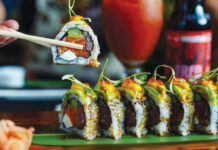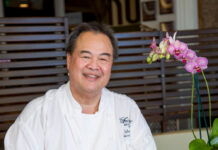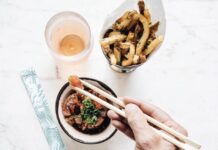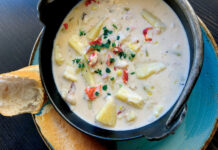Dean Louie, culinary arts instructor, Maui Culinary Academy
Chef Dean says that when he was growing up in Sacramento, “The women in my family would gather for the ‘Chinese tamale’ party. All the ingredients for the joong were prepared ahead of time: marinated pork belly, peanuts, black-eyed peas, lup cheong sausage, salted duck egg yolk and sticky rice. Then everyone would fall into the assembly line and they would make dozens.” He says, “I remember the clattering that the big tin pots made while boiling [joong] on the stove. Aromas of earthy bamboo-leaf wrappers suffused the air. We’d go in and out of the kitchen, waiting.” Until the dish was ready, Dean says, the grownups “would quell our appetites with treats such as homemade candy wrapped in waxed paper: hard and chewy, made with puffed rice, candied ginger, peanuts and sesame seeds. Sometimes I’d have to run to the local Chinese grocery store to pick up more string to tie the joong. I really miss the synergy of the family gathering. Everyone lived nearby in those days, so all the kids got to play and the women cooked and we all enjoyed the fruits of their labor.”
Norma Barroga, retired Iao Intermediate School principal
Lechon (whole, roasted pig) is a popular food memory for many Filipino immigrants and their Hawai‘i descendants. That’s true for Norma — her eyes gleam at the thought of the golden, crispy skin, called chicharron. She says, “My family in Manila would rotisserie a pig during the holidays and baste it with sugarcane, vinegar, garlic and salt. The cavity was stuffed with aromatics like lemongrass, lemon, and bay leaf. The charcoal wood fire burned on low all day, starting at sunrise, but it was worth waiting for the crunchy skin and [succulent] meat. Norma and her husband, Ernie Cronkite, don’t have the technical know-how to prepare this time-honored food, but when the urge hits, Max’s Restaurant at the Maui Mall is their go-to for lechon kawali, a modern, oven-roasted version of the lechon of Norma’s childhood.
Paris Nabavi, owner, Sangrita and Pizza Paradiso
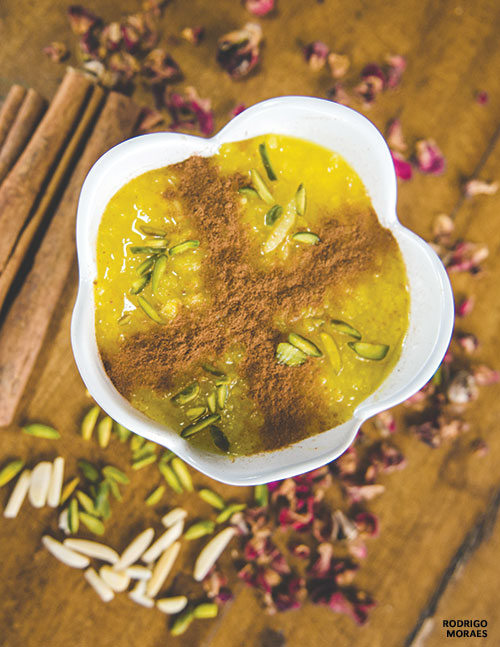
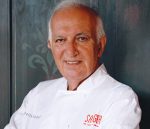 Growing up Persian and ending up on an island in the middle of the Pacific Ocean couldn’t dissuade Chef Paris from following tradition. Looking back on his childhood, he recalls one special day a year, when his entire family opened their home to the poor and homeless. The event took days to prepare. In his family compound, replete with rose gardens, fig and citrus trees, dozens of black iron cauldrons hung from tripods over wood fires to feed a thousand (yes, a thousand!) mouths. The needy came bearing two empty pots that were filled by his family and house staff. Paris says, “One pot was filled with a rich lamb stew scented with Persian dried limes, tomatoes and garlic and a creamy yellow dal; and the other held a mound of matchstick fried potatoes. I make this stew and potatoes for my own family. I still cook a traditional fish dinner topped with sour orange and served with a side of green herb rice [dill, parsley and garlic chives] on New Year’s Day. I also make a dessert from my childhood that I sell at Pizza Paradiso: rice pudding with rosewater, sugar, saffron and slivered almonds sprinkled with cinnamon. It’s a special treat . . . every day.”
Growing up Persian and ending up on an island in the middle of the Pacific Ocean couldn’t dissuade Chef Paris from following tradition. Looking back on his childhood, he recalls one special day a year, when his entire family opened their home to the poor and homeless. The event took days to prepare. In his family compound, replete with rose gardens, fig and citrus trees, dozens of black iron cauldrons hung from tripods over wood fires to feed a thousand (yes, a thousand!) mouths. The needy came bearing two empty pots that were filled by his family and house staff. Paris says, “One pot was filled with a rich lamb stew scented with Persian dried limes, tomatoes and garlic and a creamy yellow dal; and the other held a mound of matchstick fried potatoes. I make this stew and potatoes for my own family. I still cook a traditional fish dinner topped with sour orange and served with a side of green herb rice [dill, parsley and garlic chives] on New Year’s Day. I also make a dessert from my childhood that I sell at Pizza Paradiso: rice pudding with rosewater, sugar, saffron and slivered almonds sprinkled with cinnamon. It’s a special treat . . . every day.”

